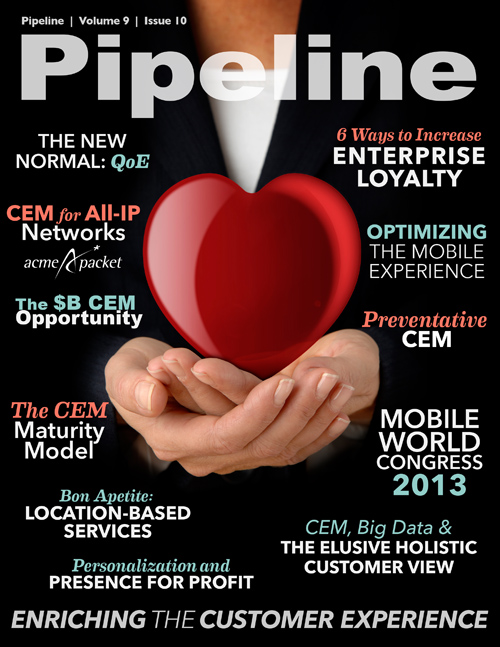Touch Points: CEM, Big Data & the Elusive Holistic Customer View
By: Becky Bracken

Implementing Big Data for communications service providers (CSPs) can be like taking a drink of water from a fire hose. A tiny sip is all you really need, but the trick lies in taking that sip without drowning — or taking your head off — in the process.
Customer experience management (CEM) can be similarly daunting. The TM Forum defines customer experience as “the result of the sum of observations, perceptions, thoughts and feelings arising from interactions and relationships between customers and their service provider(s). Virtually every customer touch point — whether directly or indirectly linked to service providers and their partners — contributes to customer perception, satisfaction, loyalty and, ultimately, profitability.”
That’s quite a mouthful. Maybe a sip from a fire hose would be an easier challenge to manage.
The art of using Big Data to recreate past customer interactions and predict those that will happen in the future, not to mention the infinite variables such a task would encompass, sounds impossible. But this is one instance in which most of the hype is true, albeit with an emphasis on “most”: there is no shortage in the number of Big Data analytics solutions that can boost CEM, but the coveted 360-degree view of the customer remains largely elusive.
According to Forrester Research, 51 percent of customer-service strategy decision-makers stated they struggle with data challenges, and that creating a single view of customer data is one of the biggest. In addition, 32 percent of enterprise decision-makers stated they can’t answer customer questions accurately or consistently because they don’t have access to the right data.
Siloed services are still a burden on Big Data solutions for CEM. Ovum telecommunications analyst Shagun Bali says most solutions in the market today leave much to be desired in terms of data integration and interoperability, and still require heavy customization and a sizable investment by both the vendor and the CSP.
“A key issue is that the best route to an integrated view is still not clear,” she explains. “Just a handful of vendors have created truly prebuilt departmental models. Others believe that each telco requires a certain level of customization, so they create a unique model each time.”
Oracle is the only vendor that has integrated various elements into a single solution, while IBM is viewed as having the most sophisticated BI (business intelligence) and analytics portfolio in the market, according to Bali.
“Given the available choice of BI and analytics solutions, telcos are in the envious position of being likely to find a solution well aligned to their specific needs,” she says. “However, the diversity of the competitive landscape means that telcos must make important strategic decisions early in the selection process about issues such as whether or not they intend to expand their BI and analytics deployments enterprise-wide and how much customization they require.”
“Real time” defined
“Real time” can have vastly different meanings for different CSPs. Generating real-time usage alerts in a prepaid environment is a much different requirement than letting customers know their bill is due in three days in a postpaid model. Large-scale, real-time analytics, including use cases that have massive, complicated computing requirements, are expensive to implement, and deciding how immediate the definition of “real time” is for a particular customer set can have a big impact on the price. Finding solutions that improve the customer experience in the most cost-efficient way possible is part of any smart Big Data solution for CEM, and establishing real time’s precise meaning for customers is central to that aim.





















